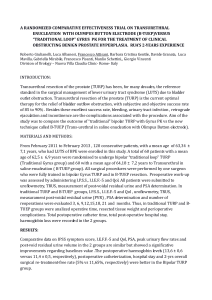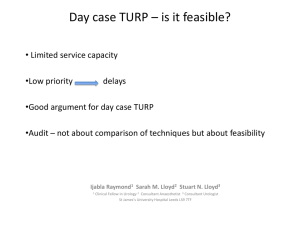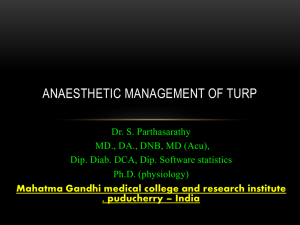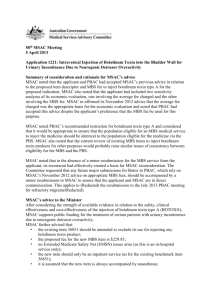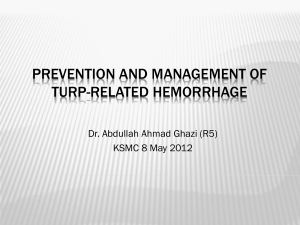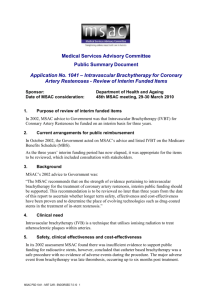Public Summary Document - the Medical Services Advisory Committee
advertisement
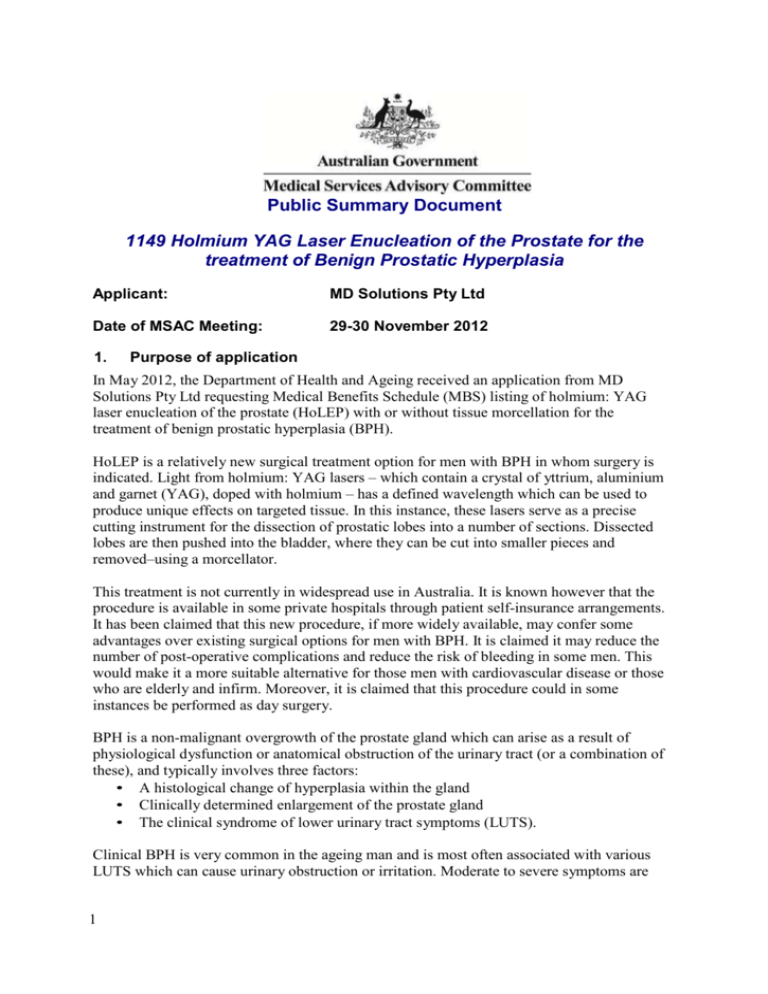
Public Summary Document 1149 Holmium YAG Laser Enucleation of the Prostate for the treatment of Benign Prostatic Hyperplasia Applicant: MD Solutions Pty Ltd Date of MSAC Meeting: 29-30 November 2012 1. Purpose of application In May 2012, the Department of Health and Ageing received an application from MD Solutions Pty Ltd requesting Medical Benefits Schedule (MBS) listing of holmium: YAG laser enucleation of the prostate (HoLEP) with or without tissue morcellation for the treatment of benign prostatic hyperplasia (BPH). HoLEP is a relatively new surgical treatment option for men with BPH in whom surgery is indicated. Light from holmium: YAG lasers – which contain a crystal of yttrium, aluminium and garnet (YAG), doped with holmium – has a defined wavelength which can be used to produce unique effects on targeted tissue. In this instance, these lasers serve as a precise cutting instrument for the dissection of prostatic lobes into a number of sections. Dissected lobes are then pushed into the bladder, where they can be cut into smaller pieces and removed–using a morcellator. This treatment is not currently in widespread use in Australia. It is known however that the procedure is available in some private hospitals through patient self-insurance arrangements. It has been claimed that this new procedure, if more widely available, may confer some advantages over existing surgical options for men with BPH. It is claimed it may reduce the number of post-operative complications and reduce the risk of bleeding in some men. This would make it a more suitable alternative for those men with cardiovascular disease or those who are elderly and infirm. Moreover, it is claimed that this procedure could in some instances be performed as day surgery. BPH is a non-malignant overgrowth of the prostate gland which can arise as a result of physiological dysfunction or anatomical obstruction of the urinary tract (or a combination of these), and typically involves three factors: • A histological change of hyperplasia within the gland • Clinically determined enlargement of the prostate gland • The clinical syndrome of lower urinary tract symptoms (LUTS). Clinical BPH is very common in the ageing man and is most often associated with various LUTS which can cause urinary obstruction or irritation. Moderate to severe symptoms are 1 recognised as significantly impacting on quality of life. The first-line management for men with BPH includes a variety of pharmaceuticals, including alpha receptor blockers, 5-alpha reductase inhibitors and anti-cholinergic drugs. However, these pharmaceuticals have both high failure and high discontinuation rates (the latter due to side effects), and the BPH symptoms in the majority of men will progress. Many of these men will eventually undergo second-line surgical treatments. In addition, some men may not opt for initial medical management. 2. Background Other surgical interventions for BPH have been assessed by MSAC in the past. These include Transurethral Needle Ablation (TUNA) for benign prostatic hyperplasia (MSAC report 1014, MBS item 37201) and high-energy Transurethral Microwave Thermotherapy (TUMT) (MBS 37230) for benign prostatic hyperplasia (MSAC report 1076). Visual Laser Ablation of the Prostate (VLAP) (MBS item 37207) has also been included on the MBS since July 1995 (which pre-dates the MSAC). 3. Prerequisites to implementation of any funding advice Twelve holmium: YAG lasers are currently TGA-registered and listed on the Australian Register of Therapeutic Goods (ARTG). Three tissue morcellators are also TGA-registered and listed on the ARTG. 4. Proposal for public funding HoLEP is proposed as an alternative procedure to Transurethral resection of the prostate (TURP) for men with moderately sized prostates (estimated to be less than 80–100g). HoLEP is further proposed as an alternative to open prostatectomy in men with larger prostates (estimated to be more than 80–100g). 5. Consumer Impact Statement Public comment was sought during the development of the final DAP. This public comment was incorporated into the final DAP as a result of PASC deliberation on 13–14 April 2011. 6. Proposed intervention’s place in clinical management There are two groups of men for whom a surgical intervention for the treatment of BPH would be indicated. These are: • Men with moderate-sized prostates (estimated at less than 80–100g) – in this group, TURP would be considered the gold standard surgical treatment. Other surgical options are currently available for this group, including VLAP, TUNA or TUMT. • Men with large prostate sizes (estimated at greater than 80–100g) – in this group, OP would be considered the gold standard. Other alternatives that are considered appropriate and currently available include a two-stage TURP procedure or VLAP. 2 It was proposed in the application that HoLEP (where it is available) could be used as an alternative to existing surgical procedures in each of the groups listed above. Figure 1: Proposed management using HoLEP 7. Other options for MSAC consideration There are two distinct patient cohorts and consideration was given as to whether two distinct items were required given the cost differential in the comparators. ESC resolved that a single item number for both cohorts was appropriate given the relatively small cohort for OP and the fact that it is a diminishing service. PASC in its deliberations, removed laser vaporisation as a comparative treatment as the proposed medical service is a type of laser vaporisation. 8. Comparator to the proposed intervention TURP MBS item number 37203, is considered the gold standard for the treatment of bladder obstruction for men with moderate prostate sizes, estimated to be smaller than 80–100g. OP 3 MBS item number 37200 (or two-stage TURP), is considered the gold standard in men with larger prostates, estimated at greater than 80–100g. There were 12,673 MBS claims for TURP procedures in the financial year 2010–2011. A much smaller number of claims during the same time period were recorded for OP (141), TUNA (too small to report), transurethral microwave therapy (TUMT) (43) and VLAP (938). Although a number of surgical options are available for men with moderate-sized prostates (less than 80–100g), only TURP was considered a suitable comparator for HoLEP in this evaluation. For men with larger prostates (greater than 80–100g), OP was the comparator that was used for assessing the evidence for HoLEP. The newer surgical interventions for BPH (that is, TUNA, TUMT and VLAP) were not considered suitable comparators because they have lower utilisation rates and represent smaller costs to the MBS relative to the gold standards. Furthermore, if approved, HoLEP would be expected to replace these procedures in centres where it would be available. TURP and OP are in-hospital procedures only. They are both listed on the MBS. The MBS item descriptors for TURP are: The MBS item descriptor for OP is: 9. Comparative safety Nine systematic reviews and HTAs that compared HoLEP with TURP and/or OP met the inclusion criteria. Four of these systematic reviews and HTAs compared HoLEP with TURP and five compared HoLEP with TURP and OP. The systematic review of Lourenco et al (2008), updated with 2 new other studies (Eltabey et al 2010 & Mavuduru et al 2009), to compare TURP and HoLEP was chosen for updating in this assessment. The Australian and New Zealand Horizon Scanning Network (ANZHSN) 2010 review of the current state of development of laser prostatectomy was chosen for updating in the comparison of HoLEP with OP. 4 The main results of HoLEP to TURP studies are illustrated by the below table: Safety outcomes: HoLEP in comparison with TURP Outcome Studies (n) Patients HoLEP /TURP (n) HoLEP (total events) TURP (total events) Estimate of effect Range (95% CI)* I2 (%) p-value Blood transfusion rate 7 348/342 1 13 RR 0.27 0.09– 0.85 0 0.02 Urethral stricture 7 322/309 14 23 RR 0.65 0.331.27 0 0.21 Incontinence 6 306/296 7 8 RR 0.84 0.31– 2.28 0 0.97 Acute urinary retention 5 293/287 15 21 RR 0.71 0.38– 1.32 8 0.28 Urinary tract infection 2 91/89 5 5 RR 0.98 0.31– 3.09 37 0.97 HoLEP appears to be as safe as TURP across the range of outcomes assessed. There would appear to be statistically significant advantages over TURP in relation to blood transfusion rates post procedure. Urethral stricture rates, dysuria, and mortality all slightly favour HoLEP but the evidence from the systematic review and two additional RCTs suggested that differences in the rates of these adverse events are not statistically significant. However, there is no in evidence of difference in safety for erectile dysfunction, TUR syndrome (hypernatremia due to the irrigation solution used during the procedure), capsular perforation and incontinence with HoLEP compared to TURP. Although, as a result of the wide confidence intervals for some of the outcomes, caution was exercised with interpretation of this information. Main results of HoLEP to OP studies are illustrated by the below table: Outcome Studies (n) Patients HoLEP /OP (n) HoLEP (total events) OP (total events) Estimate of effect (RR) Range (95% CI)* I2 (%) p-value Blood transfusion rates Urethral stricture 2 101/99 2 15 0.19 0.05– 0.73 0 p=0.02 2 101/88 5 4 1.07 0.30– 3.87 0 p=0.91 Incontinence 2 97/99 7 9 0.79 0.31– 2.04 0 p=0. HoLEP also appears to be as safe as OP across the range of outcomes assessed, although this information was analysed from fewer studies and with a smaller number of patients. In a meta-analysis of the two studies, patients allocated to HoLEP were less likely to have a blood transfusion than those allocated to TURP. Other complications, such as incontinence and stricture, were comparable between the groups. 5 10. Comparative effectiveness The evidence base for the comparison of HoLEP and OP comprised of two randomised controlled trials with 100 patients in total in each arm. Results from these trials are consistent, and probably generalisable to the Australian population. TURP as the comparator HoLEP appeared to be as effective, or more effective, than TURP across a range of effectiveness outcomes. These included peak flow (Qmax), symptom scores and PVR (Post Void Residual). It was noted that caution should be exercised in the interpretation of some of these findings given wide confidence intervals and significant heterogeneity across the studies. Quality of life differences and differences between the two interventions in respect of treatment failure/re-treatment rates were not significant. The table below indicates that HoLEP takes slightly longer, but there is a shorter hospital stay. Outcome Studies (n) Patients HoLEP /TURP (n) HoLEP (mean) TURP (mean) Estimate of effect (MD) Range (95% CI)* I2 (%) p-value Duration of operation (min) 6 331/336 70 54.6 15.8 8.7– 21.5 72 p<0.001 Duration of catheterisa tion (hours) 6 285/282 31.1 53.4 22.4 28.2– 16.6 80 p<0.001 Duration of hospital stay (days) 5 281/276 1.9 3.0 1.1 1.26– 0.89 28 p<0.001 OP as the comparator HoLEP appeared to be as effective as OP across a range of effectiveness outcomes, albeit with a smaller body of evidence. These included Qmax, symptom scores and PVR. No evidence of superiority for HoLEP (or OP) was demonstrated. A HoLEP procedure takes longer to complete than a TURP procedure, but is associated with a statistically significantly shorter hospital stay. Catheterisation times are also shorter. Surgeon experience was often not noted in the studies and so it was difficult to ascertain whether these results would reflect current operative times. HoLEP appeared to be as effective as OP, based on the evidence from two RCTs, across a range of effectiveness outcomes. These included Qmax, symptom scores and PVRs. No evidence of superiority for HoLEP (or OP) was demonstrated from either of the studies. It was not possible to adequately address, from the data available, the differences between the interventions with respect to quality of life or treatment failure/re-treatment rates. A HoLEP procedure may take longer to complete than an OP procedure, but may be associated with a shorter hospital stay and shorter catheterisation times. These data should however be interpreted with caution. 6 11. Economic evaluation The reviewed literature’s focus was not a direct comparison of HoLEP against TURP or OP, and used overseas costs and inputs. As a result a cost utility analysis was undertaken that examined the costs and benefits of a number of surgical treatment strategies for BPH that included either HoLEP and/or TURP for men with prostate sizes of less than 80-100g or HoLEP and/or OP for men with larger prostates. A Markov model was developed, allowing patients to transition through health over a time horizon of five years. Individual cycle lengths were six months with half-cycle correction employed to account for the continuous nature of transition probabilities within a cycle. Five years was chosen based on the availability of clinical effectiveness data used in the meta-analysis. In accordance with the DAP, patients who failed an initial HoLEP procedure could be re-treated with either HoLEP or TURP. Patients who failed a TURP procedure would be re-treated with TURP. In the OP comparison, patients who failed an initial HoLEP could be re-treated with either HoLEP or OP. There was no treatment alternative to a failed OP. The model included health states of: initial treatment (with or without adverse events); well; long-term side effects; treatment failure; repeat treatment (with or without adverse events); treatment for urethral stricture; and death (all-cause mortality). The transition through these health states was determined from the result of the literature review and meta-analysis. The adverse events data was derived from studies which presented worse-case scenario analysis. The utility values were as previously estimated by Kok et al 2002, such that the utility associated with urethral stricture was the same as that for long-term incontinence. TURP as the comparator Costs of TURP and OP procedures were taken from the private hospital weighted AR-DRG costs (with or without complications). Costs for HoLEP procedures were derived based on the TURP MBS usage data. In both economic evaluations, HoLEP treatment was demonstrated to be associated with lower average per-patient treatment costs than treatment options including either TURP or OP, with equivalent or near equivalent effectiveness. This lower cost was driven by the reduced length of stay required for HoLEP treatment, as well as reduced rates of adverse events, long-term incontinence and treatment failure. In the base case analysis, there was a marginal increase in effectiveness for TURP (with repeat TURP upon failure) of 0.008 QALYs. This was considered to be an artefact of the calculation of patient progression through the model, and the two treatments could be considered equally effective. The incremental cost-effectiveness ratio of HoLEP (with HoLEP upon failure) was modelled to be $179,725 saved per QALY lost over TURP (with TURP upon failure). This result was driven by the marginal difference in effectiveness between the treatment options. Overall, HoLEP treatment was associated with lower average per-patient costs with near equivalent effectiveness. OP as the comparator The treatment pathway employing HoLEP followed by a second HoLEP upon initial treatment failure was found to have a lower average per-patient cost than OP. The reduction of cost was primarily driven by a reduced cost of treatment as a result of HoLEP requiring a reduced length of stay (LOS) than OP. HoLEP treatment pathways were marginally more effective than those employing OP with a marginal increase of ~0.006 QALYs compared to 7 OP treatment alone. HoLEP treatment (with either HoLEP or OP upon treatment failure) dominated OP treatment in that they were less costly and more effective. The inputs used in the economic evaluation assessing the treatment of BPH in men with an expected prostate size >80-100g using either HoLEP or OP was based upon data published in two clinical trials with 200 patients in total. Thus, whilst the evidence at hand suggested that HoLEP is a cost-effective treatment option for BPH compared to OP, some caution should be exercised in drawing firm conclusions from the assessment. Sensitivity analyses Treatment pathways that included HoLEP remained cost-effective against either TURP or OP across a range of variables tested in sensitivity analysis. TURP (with TURP for re-treatment) was more cost-effective than HoLEP in one scenario only. This was with an increased cost of HoLEP associated with a longer length of stay coupled with the highest confidence interval relative risk of HoLEP re-treatment for failure. This resulted in the ICER being most sensitive to changes in the relative risk of experiencing strictures. Economic modelling to assess the costs and effects of various treatment options for BPH was undertaken. The economic evaluations showed that HoLEP treatment was associated with lower average per-patient treatment costs than treatment options including either TURP or OP, with very similar effectiveness. This lower cost was driven by the reduced length of stay required for HoLEP treatment, as well as reduced rates of adverse events, long-term incontinence and treatment failure. As the results for HoLEP compared with OP are based on a relatively small number of trials with small numbers of patients, the comparative cost-effectiveness of HoLEP treatment compared with OP was investigated using a wide range of values in the sensitivity analyses. HoLEP treatment was consistently found to be associated with a lower average per-patient treatment cost, and superior effectiveness. For example, when the costs associated with a LOS for HoLEP were adjusted upwards from two to three days, HoLEP treatment remained a more cost-effective strategy. As such, the availability of more data could be anticipated to reduce this uncertainty rather than alter the outcome of the assessment. HoLEP appeared to be a cost-effective alternative to either TURP or OP in the surgical management of men with BPH. This was primarily due to reduced costs associated with the procedure, in turn driven by reduced lengths of stay in hospital and reduced complications. Scenarios that would reduce the cost-effectiveness of the procedure would include increased lengths of hospital stay or increased rates of re-operations required for the re-treating BPH. A number of potential MBS fees were listed in the DAP. The maximum of these fees was used in the base case which included a premium of 20% for training to provide the service. This premium for training was requested by the applicant and included in the modelling but it is not applicable for funding under Medicare policy and therefore has to be removed from the final proposed fees. It should be noted any reduction in the fee from base case which had the 20% premium and morcellation rendered the treatment more cost-effective. The capital outlay of the equipment and additional training required will influence the uptake of the procedure and also theatre banding for consumables. 12. Financial/budgetary impacts HoLEP is proposed as a replacement for existing treatments and the impact on service volumes would be negligible. There would be a learning curve to develop skills in the 8 procedure. Therefore, it is likely that uptake of the procedure following positive listing would initially be slow, and increase gradually over time. Estimates of uptake of the procedure over a five year period in the event of a positive listing ranged from 1% of the total number of TURP procedures that are performed annually by year 1 and rising to 10% by year 5. Table 41: Projected numbers of MBS claims from 2013-2017 in event of positive MBS listing TURP procedures OP procedures HoLEP procedures replacing TURP HoLEP procedures replacing OP Total HoLEP procedures Total number of BPH procedures 9 2012 2013 Year 1 2014 Year 2 2015 Year 3 2016 Year 4 2017 Year 5 12500 12375 12125 11875 11500 11250 150 142 142 142 142 142 0 125 375 625 1000 1250 0 8 8 8 8 8 0 133 383 633 1008 1258 12650 12650 12650 12650 12650 12650 (Amended) Table 42: Projected total costs to the MBS over a five year period: listing of HoLEP with morcellation Item fee 2012 2013 Year 1 2014 Year 2 2015 Year 3 2016 Year 4 2017 Year 5 12500 12375 12125 11875 11500 11250 150 0 142 133 142 383 142 633 142 1008 142 1258 $1,002.65 $12,533,125 $12,407,794 $12,157,131 $11,906,469 $11,530,475 $11,279,813 $977.80 $146,670 $138,848 $138,848 $138,848 $138,848 $138,848 TURP procedures OP procedures Total HoLEP procedures TURP MBS fees OP MBS fees HoLEP MBS fees (with or without morcellation) $1,423.18 $- $189,283 $545,078 $900,873 $1,434,565 $1,790,360 HoLEP MBS fees (with morcellation less 20% premium) Total MBS fees for BPH procedures over 5 years (HoLEP fee $1423.18) Total MBS fees BPH procedures (HoLEP fee $1222.70) Additional costs/year with HoLEP listing (HoLEP fee $1423.18) Additional costs/year with HoLEP listing (HoLEP fee $1222.70) Total additional cost to Government (75%) HoLEP fee $1423.18 Total additional cost to Government (75%) HoLEP fee $1222.70 $1,222.70 $- $162,619 $468,294 $773,969 $1,232,482 $1,538,157 $12,735,924 $12,841,057 $12,946,189 $13,103,888 $13,209,021 $- $12,709,260 $12,764,273 $12,819,285 $12,901,804 $12,956,817 $- $56,129 $161,262 $266,394 $424,093 $529,226 $- $29,465 $84,478 $139,490 $222,009 $277,022 $- $42,097 $120,946 $199,796 $318,070 $396,919 $- $22,099 $63,358 $104,618 $166,507 $207,766 10 $12,679,795 Based on the projections outlined, it is estimated that the additional annual cost to the MBS in 2015 as a result of positive listing of this procedure as per the proposed descriptor would be $199,796. This would rise to $396,919 by year 5. These costs reflect only the 75% benefit for the item and it is expected that any additional costs would be out-of-pocket. Therefore, if listed, HoLEP would have an additional direct cost to the MBS on an annual basis as a result of the increased fee for the item. The cost offsets that arise from reduced length of stay and reduced complications would accrue to hospitals, to health insurers and to patients. 13. Key issues for MSAC from ESC Main issues around the proposed eligible population for public funding and/or the proposed main comparator ESC was unsure if there was any advantage specifying the indication for HoLEP as moderate to severe BPH in the descriptor given that there is unlikely to be leakage to either mild BPH patients or any other patients if this specification is not included. However good practice is to have a descriptor that is specific to the population which ESC has examined. ESC agreed that HoLEP will be used primarily as a replacement for existing therapies for moderate-to-severe BPH patients and is not expecting it will increase the overall pool or prevalence of patients being treated for BPH. Main issues around the evidence and conclusions for safety? ESC agreed the comparative evidence for safety of HoLEP to either TURP or OP would indicate that HoLEP was as safe as or safer than the current comparators. ESC noted that there was no trial data for two stage TURP compared to HoLEP. The safety issues for two stage TURP do not appear to be significantly different from those associated with a single TURP but there are no data to support or deny this position. Main issues around the evidence and conclusions for clinical effectiveness? ESC noted that Bother scores were suggested in the in DAP as a means of assessing effectiveness but were not able to be provided in the report due to the absence of any studies using them as a primary measure of effectiveness. ESC agreed the evidence for clinical effectiveness of HoLEP compared with either TURP or OP would indicate that, given the marginal differences in QALYs in either comparsion, HoLEP could be considered as having equivalent effectiveness, subject to the caveat that there is a high degree of the heterogeneity between studies and small numbers of studies available to support this position. Other important clinical issues and areas of clinical uncertainty? ESC did not consider in the second population that open prostatectomy was the most likely clinical treatment to be used at present, as indicated by the MBS usage data. As a result of this ESC felt HoLEP was more likely to be used as a substitute for TURP, especially as the number of practitioners performing OP is diminishing. Main economic issues and areas of uncertainty? ESC felt the negative utility gain for HoLEP causes it to appear to be inferior rather than noninferior in terms of effectiveness. This is due to interpretation of the data given for the safety outcomes. However when looking at the effectiveness scores (Qmax, IPSS/AUA, PVR and QALY) of HoLEP compared to TURP it shows that HoLEP has much better 6 and 12 month mean health outcomes. 11 ESC also questioned the validity of some of the utility weights used: for example, using the same utility weight for urethral stricture and long term incontinence seems inappropriate as stricture is usually treatable while incontinence is a long term complication. ESC also noted that the hospitalisation costs avoided by HoLEP due to lower bleeding have not been factored into the Markov model and subsequent effectiveness modelling. ESC was also concerned to use that AR-DRG has been used for HoLEP compared to MBS for OP and TURP which means there has been two different sources for the costs, which may have led to an error in interpretation of relative risk. ESC felt the Markov model was fundamentally flawed due to the uncertainty as to the origin of the utility weights, the transitions through the health states, the use of non-comparable cost data, the exclusion of the avoided hospital costs, and the inclusion of a training premium in the suggested Schedule fee. Further ESC questioned the consistency of the results of the incremental QALYs gained from the model when compared with the conclusions of the clinical evaluation and the relative risks included in the model and asked the assessment group to verify the model (Attached as Errata). ESC’s judgment is that these flaws are likely to have imparted a very conservative bias against HoLEP to the analysis. ESC noted that without the claimed premium for training then there would be a small increase in MBS outlays. However, savings elsewhere in the health care system, primarily due to the decrease in hospital costs through reduced LOS and/or reduced bleeding impacts, will likely more than offset these additional MBS outlays. ESC suggests that the uptake from TURP and OP to HoLEP may be faster than predicted but this will be affected by the co-payments requested. Any other important areas of uncertainty (e.g. budget impact, translation of clinical evidence into the economic evaluation, linkage between an investigative intervention and a subsequent therapeutic intervention and outcomes? ESC discussed the issue of having one MBS item for HoLEP with or without morcellation compared with two items and differential Schedule fees for HoLEP with and without morcellation. While morcellation increases the cost of HoLEP and therefore provides a justification for having two items, ESC was concerned that this approach may provide a financial incentive to provide morcellation in circumstances where it might not otherwise be deemed necessary. ESC therefore considers that a single MBS item with a Schedule fee reflecting a “weighted average” cost of performing HoLEP with or without morcellation may be preferable. This accords with the applicant’s request for one MBS item for HoLEP. ESC was unsure of the adverse events associated with morcellation and in what way these may negatively affect the QALY. 14. Other significant factors The applicant requested 20% premium for training. This is not applicable for funding under Medicare policy and therefore has to be removed from the final proposed fees. As a result an errata has been produced to more accurately reflect costs to the MBS. MSAC agreed with the applicants request to leave the descriptor as using holmium: YAG but did not agree with the need for it to specify laser equipment with power greater than or equal to 100 watts. 12 Error or changes to text Section and page Page xxi of the Executive Summary - penultimate sentence Page 73 of the Conclusions – penultimate sentence. Page 64of the financial considerations, fourth bullet point Current text ‘…would be $201 465 by year 3 rising to $398,589 by year 5.’ Revised text ‘...would be $104,618 by year 3 rising to $207,766 by year 5 (based on a fee of $1222.70). Details Current text based on fee of $1423.18 from Table 42 p .65 Revised fee calculated as $1,222.70 ‘and a rate of 10% by year 10.’ ‘and a rate of 10% by year 5.’ Typographical error: Text was inconsistent with table and conclusions Page 64of the financial considerations, Table 41 ‘OP Procedures/HoLEP procedures replacing OP Page64 of the financial considerations, Table 41 – sixth column Page 65 of the financial considerations, Table 42 and Table 43 Incorrect calculation: 5% of 150 is written as 13 Should read: 142 for OP Procedures2013-2017 and 8 for HoLEP procedures 2013-2017 Revised to assume an increase in 2016 Calculation error Revised to reflect different costs to the MBS based on varying fees Table heading: ‘Total cost to the MBS over a five year period’ Formatting error Figures in 2015 and 2016 are identical Tables are identical despite based on different fees Table heading: total cost over a five year period Assumption of plateauing in years 3-4 15. Summary of consideration and rationale for MSAC’s advice MSAC considered that HoLEP would be used primarily as a replacement for existing therapies for moderate-to-severe benign prostatic hyperplasia (BPH) patients and did not expect that it would increase the overall pool or prevalence of patients being treated for BPH. MSAC agreed that the evidence for the safety of HoLEP compared to either transurethral resection of the prostate (TURP) or open prostatectomy (OP) indicates that HoLEP is as safe as or safer based on an overall non-statistically significant trend favouring HoLEP. MSAC agreed that its safety compared to TURP or OP, especially in relation to a statistically significant reduced requirement for blood transfusions had been overemphasised in the application. MSAC agreed that the evidence for clinical effectiveness of HoLEP compared with either TURP or OP indicates that, given the marginal differences in quality-adjusted life-years gained in either comparison, HoLEP could be considered as having equivalent effectiveness, subject to the caveats that there is a high degree of heterogeneity across the studies and there are few studies available to support this position. MSAC noted that, in relation to clinical effectiveness, HoLEP takes 16 minutes longer to perform than the current interventions due to the difficulty of the procedure, but the length of hospital stay is significantly reduced. The reported measures of symptomatic relief show trends in favour of HoLEP at discharge, and at 6, 12 and 24 months, with some of these results being reported as statistically significant. Similarly, the difference in proportions of patients requiring retreatment due to procedure failure also shows a trend in favour of HoLEP, but is not statistically significant. MSAC noted the paucity of long term follow up data, but considered that there was little difference in stricture rates between the current and proposed interventions over the reported time horizon. 13 MSAC noted that HoLEP could be performed earlier for patients in whom OP is needed, thus the reduced time to treatment may have other societal benefits, including the reduction of other related services and drug interventions. MSAC raised concerns regarding the availability of a quality assurance program to ensure the use of an appropriate laser and technique. MSAC discussed that, given the 2010–2011 MBS claims were 12,673 for TURP and 141 for OP, and small numbers of transurethral needle ablation, transurethral microwave therapy and visual laser ablation of the prostate procedures, there was both a clinical need for the proposal, but also single and two stage TURP would be where the majority of savings might occur. MSAC noted that, in both economic evaluations, HoLEP treatment was demonstrated to be associated with lower average per-patient treatment costs than treatment options including either TURP or OP, with equivalent or near equivalent effectiveness. This lower cost was driven by the reduced length of hospital stay required for HoLEP treatment, as well as reduced rates of adverse events, long-term incontinence and treatment failure. MSAC agreed that a fee range of $1,000-$1,262 was reasonable and is cost-effective, but indicated that the Department could consider if the percentage of occasions on which morcellation would not be used should reduce the overall offered fee, as there was no information with respect to percentage of use per treatment in which morcellation would be used. MSAC also suggested the Department could consider if the amortisation of the cost of the equipment included in the offered benefit would reduce over time or if this would encourage a clinician to maintain their equipment to the highest standard of clinical efficacy for holmium YAG lasers. MSAC agreed with the applicant’s request that the holmium YAG laser should be specified in the MBS item descriptor, but did not agree that the descriptor should prevent the use of laser equipment with a power less than 100 watts. MSAC noted the applicant requested a 20% premium for training. However, MSAC agreed this is not applicable for funding under Medicare policy and therefore will have to be removed from the final proposed fees. 16. MSAC’s advice to the Minister After considering the strength of the available evidence in relation to the safety, effectiveness and cost-effectiveness of holmium YAG laser enucleation of the prostate (HoLEP), MSAC supports public funding for holmium YAG laser enucleation for the treatment of benign prostatic hyperplasia (BPH). 14 MSAC agreed the following MBS item descriptor: 17. Applicant’s comments on MSAC’s Public Summary Document Feedback from members of the Urological Society of Australia and New Zealand to us has been very positive. They have acknowledged that recognition of the HoLEP procedure for Benign Prostatic Hyperplasia through the institution of an appropriate MBS item number is a welcome addition to the schedule. The MD Solutions website is www.mdsanz.com. 18. Context for decision This advice was made under the MSAC Terms of Reference. MSAC is to: Advise the Minister for Health and Ageing on medical services that involve new or emerging technologies and procedures and, where relevant, amendment to existing MBS items, in relation to: • the strength of evidence in relation to the comparative safety, effectiveness, costeffectiveness and total cost of the medical service; • whether public funding should be supported for the medical service and, if so, the circumstances under which public funding should be supported; • the proposed Medicare Benefits Schedule (MBS) item descriptor and fee for the service where funding through the MBS is supported; • the circumstances, where there is uncertainty in relation to the clinical or costeffectiveness of a service, under which interim public funding of a service should be supported for a specified period, during which defined data collections under agreed clinical protocols would be collected to inform a re-assessment of the service by MSAC at the conclusion of that period; • other matters related to the public funding of health services referred by the Minister. Advise the Australian Health Ministers’ Advisory Council (AHMAC) on health technology assessments referred under AHMAC arrangements. MSAC may also establish sub-committees to assist MSAC to effectively undertake its role. MSAC may delegate some of its functions to its Executive sub-committee. 19. Linkages to other documents MSAC’s processes are detailed on the MSAC Website at: www.msac.gov.au. 15
